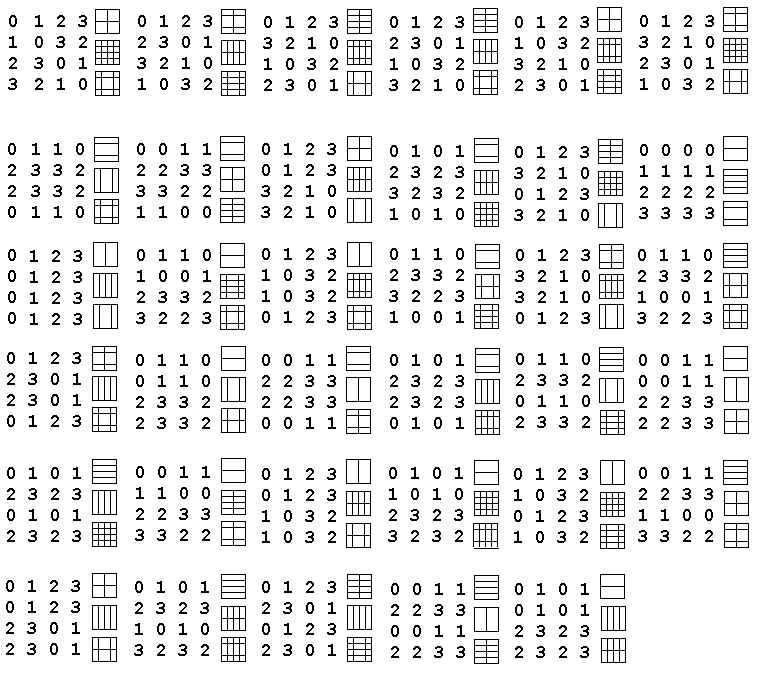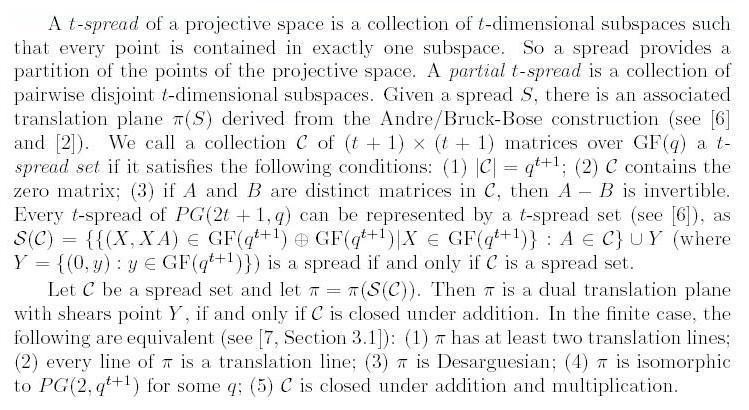|
From Some
new maximal sets of
mutually orthogonal Latin squares:
"Let us briefly sketch the connection between partial spreads
in PG(3,q) and sets of mutually orthogonal Latin squares
of order q2. Any r mutually skew lines in PG(3,q)
may be viewed as a collection of r pairwise disjoint subgroups
of order q2 in the additive group of the vector
space V = V(4,q) (meaning, of course, that any
two of these subgroups intersect trivially). This is a particular
example of a so-called partial congruence partition (PCP) and
therefore leads to a (translation) net of order s = q2
and degree r by taking the vectors in V as points and
all the translates of the specified r subgroups as lines, cf.
[9] or [2]. If the given partial spread is actually maximal, one may
hope that the associated net is likewise maximal, resulting in t
= r - 2 MAXMOLS(s), s = q2.
This approach has been used successfully by Jungnickel [10,
11]. However, in general, the associated net may well be
extendable; it is easily seen that this happens if and only if the net
admits a transversal, i.e., a set of s points meeting
every line of the net in a unique point.
In the present note, we will use maximal partial spreads of
size r in PG(3,4)\PG(3,2) to construct
transversal-free translation nets of degree r + 3; this
approach will give our new examples of MAXMOLS(16)."
References for
Some
new maximal sets of
mutually orthogonal Latin squares:
1. D. Bedford and R. M. Whitaker, New and old values for
maximal MOLS (n), Ars Comb., Vol. 54 (2000), pp. 255-258.
2. T. Beth, D. Jungnickel and H. Lenz, Design Theory, 2nd ed.
Cambridge University Press (1999).
3. C. J. Colbourn and J. H. Dinitz, The CRC Handbook of
Combinatorial Designs, CRC Press, Boca Raton (1996).
4. E. Cornelis and H. Vernaeve, Spreads in PG(3,4)\PG(3,2).
Project for the computer algebra course, Computational Group Theory,
Ghent University (2000).
5. D. A. Drake, G. H. J. van Rees and W. D. Wallis, Maximal sets of
mutually orthogonal Latin squares, Discr. Math., Vol. 194
(1999), pp. 87-94.
6. R. H. Dye, Partitions and their stabilizers for line complexes and
quadrics, Ann. Mat. Pura Appl., Vol. 114, No. 4 (1977), pp.
173-194.
7. The GAP Group, GAP -- Groups, Algorithms, and Programming,
Version 4.1 http://www-gap.dcs.st-and.ac.uk/~gap (1998).
8. J. W. P. Hirschfeld, Finite Projective Spaces of Three
Dimensions, Oxford University Press (1985).
9. D. Jungnickel, Existence results for translation nets, in (P. J.
Cameron, J. W. P. Hirschfeld and D. R. Hughes, eds.) Finite
Geometries and Designs, Cambridge University Press (1981), pp.
172-196.
10. D. Jungnickel, Maximal partial spreads and translation nets of
small deficiency, J. Algebra, Vol. 90 (1984), pp. 119-132.
11. D. Jungnickel, Maximal partial spreads and transversal-free
translation nets, J. Combin. Theory Ser. A, Vol. 62 (1993), pp.
66-92.
12. D. Jungnickel, Maximal sets of mutually orthogonal Latin squares,
in (S. Cohen and H. Niederreiter, eds.) Finite Fields and
Applications, Cambridge University Press (1996), pp. 129-153.
13. D. Jungnickel and L. Storme, Maximal partial spreads in PG(3,4)
and maximal sets of mutually orthogonal Latin squares of order 16, Discr.
Math., Vol. 26 (2003), pp. 361-372.
14. W. M. Kantor, Ovoids and translation planes, Canad. J. Math.,
Vol. 34 (1982), pp. 1195-1207.
15. K. Mellinger, A note on line-Baer subspace partitions of PG(3,4).
J. Geom., Vol. 72 (2001), pp. 128-131.
16. T. Penttila, Personal communication, December 14 (2001).
17. E. E. Shult, Nonexistence of ovoids in Omega+(10,
3), J. Combin. Theory Ser. A, Vol. 51 (1989), pp.
250-257.
18. J. A. Thas, Polar spaces, generalized hexagons and perfect codes, J.
Combin. Theory Ser. A, Vol. 29 (1980), pp. 87-93.
19. J. A. Thas, Ovoids and spreads of finite classical polar spaces, Geom.
Dedicata, Vol. 10 (1981), pp. 135-144.
20. J. A. Thas, Ovoids, spreads and m-systems of finite
classical polar spaces, in (J. W. P. Hirschfeld, ed.), Surveys in
combinatorics, 2001, Cambridge University Press (2001), pp. 241-267
|


